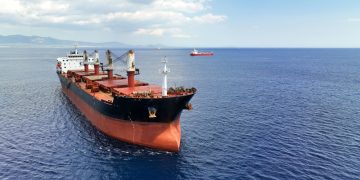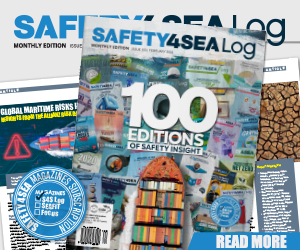The Singapore-flagged chemical tanker ‘Bow Mariner’ sank off Virginia after a fire broke out while its crew was engaged in cleaning residual from cargo tank, resulting in the death of 21 people, total loss of the ship, as well as significant marine pollution. The accident is defined as a very serious casualty and one of worst ever deep-sea chemical tanker disasters in terms of loss of life.
The accident
At 1805 on Saturday, 28 February 2004, the Odfjell-owned ‘Bow Mariner’ was en route from New York to Texas, with a cargo of 11,570 tons of industrial ethanol, when it caught fire and exploded, while the crew was engaged in cleaning residual Methyl Tert Butyl Ether (MTBE) from cargo tank number eight starboard. The fire was followed by two significant explosions that occurred less than two minutes apart, at 1806 and at 1808. The explosions caused catastrophic structural damage and led to immediate flooding. The ship sank by the bow at 19.37, one hour and 32 minutes after the first explosion, about 45 nm east of Virginia. The Bow Mariner spilled about 3,188,711 gallons of ethyl alcohol, 192,904 gallons of HFO, 48,266 gallons of LFO, and an unknown quantity of slops in US waters.
Fatalities
Of the 27 crew onboard:
- Six abandoned the ship and were able to make it to an inflatable life raft and were rescued by the USCG.
- Three were found dead: An unknown number of other crew members abandoned the ship to the water, one of whom were recovered deceased and two of whom were recovered alive by USCG and good Samaritan vessels, but died before reaching to hospital.
- 18 crew remain missing and are presumed dead.
USCG Investigation
The explosion was caused by the ignition of a fuel/air mixture, either on deck or in the cargo tanks, that was within its flammable units, leading to a fire on deck. However, the ignition source could not be determined. Possible sources of ignition included electrostatic discharge, mechanical sparks or electrical sources, while less possible sources include cell phones, sabotage, smoking.
In its investigation report, the US Coast Guard has laid particular emphasis on the Master’s order to open for cleaning the lids of 22 tanks that had been carrying MTBE, which caused flammable vapors heavier than air to accumulate on deck and diluted the fuel-rich atmosphere in the cargo tanks with oxygen, bringing them to flammable range. This action was “breach of normal safe practices for a tank ship and defies explanation or excuse,” USCG noted.
Contributing to the casualty was failure of the operator and the senior officers of the ship to properly implement the company’s Safety, Quality and Environmental Protection Management System (SQEMS). This is the first time in history that noncompliance and failure of Operator and crew to properly implement SQEMS has been recorded as a contributing cause to an accident.
Investigators also noted the crew was inefficiently unprepared for an emergency, because fire and boat drills were rarely performed.
Another significant issue was the lack of immersion suits that also contributed to loss of life, as there was sufficient time for survivors of the explosion to don immersion suits before entering the water, had there existed any.[/two_third_last]
USCG recommendations
On the aftermath of the casualty, the USCG recommended the manager company to review their internal policies and procedures in the workforce interaction and cooperation.
The USCG also proposed IMO, INTERTANKO and ICS to jointly examine the causes of all tank vessels explosions involving tank cleaning in the previous five years.
It also advised Commandant to send a message to all marine safety field units emphasizing the importance of randomly verifying a tank vessel’s compliance with SMS for tank cleaning, confined space entry and tests and inspections of equipment.
Lessons to be learned This maritime casualty, along with many others, underlines the disaster that can be provoked by the lack of simple compliance with procedures: The importance of implementing the SQEMS: The cargo tanks were not inerted during the discharge of MTBE in New York and they were not required to by the US law, because the ship was built before 1986. If simply the tanks had remained closed, the explosion would not have occurred. The opening of the 22 cargo tanks that had previously held MTBE was a major safety violation by the Captain, defying any explanation, according to the USCG. This caused flammable vapors heavier than air to accumulate on deck and diluted the fuel-rich atmosphere in the cargo tanks with oxygen, bringing them to flammable range. Even more, the accident highlights the need to follow procedures in an emergency: The insufficient emergency response, the lack of immersion suits onboard, and the Captain leaving the ship without distress calls and without conducting a muster for the injured crew, as well as without attempting to launch primary lifesaving appliances were a deadly mix for the aftermath of the explosion. The USCG report notes that this improper preparedness was resulted from insufficient training, as the Captain did not conduct regular boat drills: In this casualty, the officer on watch failed to sound the general alarm and to send a distress signal, while there had been panic at the time, with no crewman reported to their muster stations with the equipment they had to bring and with no one knowing what to do. As such, concerns on procedural compliance are further extended to concerns of effective leadership: The explosion and sinking of Bow Mariner leaves the shipping community with thoughts regarding hierarchy and dysfunctional leadership aboard ships and behavior culture.
READ USCG INVESTIGATION REPORT HERE
The following video by USCG records Bow Mariner sinking:
LEARN FROM THE PAST: Read in this series


















































































































I really do not know if industry has learned properly and actually the lesson.
We are still looking for zero accidents and incidents, however and as Mr Belokas correctly mentioned in his last article are we trying to detect unsafe behaviors and practices?
We must consider the behaviour as a consequence and not as the cause. In order to achieve that level we need to upgrade our systems for the specific target, but for this we need the right people to be allowed to follow the target.
If right people exist in our industry and within our Organization do they have enough time to follow the target? with how many tasks these people are engaged?